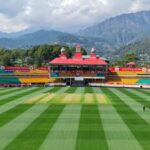
From October 5 to November 19, 2023, India will host the ICC Men’s Cricket World Cup, with 10 nations competing in a round-robin style at 10 locations. Some of the top cricket players will compete in the competition, which will also highlight India’s diversity and beauty. However, not every team will enjoy a trouble-free World Cup experience because some of the grounds could present difficulties for the batsmen. Based on the previous ODI games played there, the lowest score at each World Cup 2023 venue is shown below.
These venues’ ground sizes vary depending on their form, size, and layout. The following minimum and maximum boundaries have been established by the ICC for the World Cup matches:
– The playing field must be at least 150 yards (137.16 meters) long, with the shorter of the two square bounds being at least 65 yards (59.43 meters).
– The pitch’s straight boundary at each end must be at least 70 yards (64.00 meters) long.
– Distances must be calculated from the center of the playing field.
– Providing the largest playing area is the goal in every situation, provided that no border extends more than 90 yards (82.29 meters) from the center of the field being used.
1.With a capacity of 132,000 spectators, Ahmedabad’s “Narendra Modi Stadium” is the world’s biggest cricket venue. One of the longest grounds in the competition, it has a square border of 73 yards and an 80-yard straight boundary. In 2011 and 2015, the stadium played host to two World Cup games, and in 2023, it will host seven games, including a semifinal.
2.The 40,000-seat M. Chinnaswamy Stadium in Bengaluru is one of the most well-liked stadiums in India. Its square boundary is 66 yards and its straight boundary is 70 yards, both of which are near to the ICC’s minimal standards. The stadium is renowned for its exhilarating atmosphere and high-scoring games. In 2023, it will serve as the site of six games, including a quarterfinal.
3.One of the first cricket venues built in India, the 50,000-seat M. A. Chidambaram Stadium is located in Chennai. Its straight and square boundaries, which are both 76 yards long, are slightly longer than typical for World Cup grounds. The stadium is renowned for its spin-friendly fields and devoted supporters. In 2023, it will serve as the site of six games, including a quarterfinal.
4.With a capacity of 41,842 spectators, Delhi’s “Arun Jaitley Stadium” is the second-largest cricket stadium in India. Its straight and square boundaries, which are also slightly longer than usual for World Cup stadiums at 73 yards and 67 yards, respectively. The stadium is renowned for its eclectic attendance and erratic weather. In 2023, it will serve as the site of six games, including a quarterfinal.
5.With a capacity of 23,000 spectators, the HPCA Stadium in Dharamsala is one of the world’s most beautiful cricket stadiums. Its straight and square boundaries, which are both close to the ICC’s minimum standards of 71 and 65 yards, respectively. The stadium, which stands 1,457 meters above sea level, provides a breathtaking perspective of the Himalayas. In 2023, it will host four games.
6.One of the newest cricket venues in India is the 55,000-seat “Rajiv Gandhi International Cricket Stadium” in Hyderabad. Its straight and square boundaries, which are both 75 yards long, are slightly longer than typical for World Cup grounds. The stadium is renowned for its cutting-edge features and energetic attendance. In 2023, it will host six games.
7.With a seating capacity of 66,000, Kolkata’s Eden Gardens is one of the most recognizable cricket grounds in the world. One of the longest grounds in the competition, it has a square border of 72 yards and an 80-yard straight boundary. The stadium has a devoted following and has played host to some iconic cricket matches and events. In 2023, seven games, including the championship, will be held there.
8.One of India’s newest cricket venues, the BRSABV Ekana Cricket Stadium in Lucknow has a seating capacity of 50,000 spectators. Its straight and square boundaries, which are both 74 yards long, are slightly longer than typical for World Cup grounds. The stadium is renowned for its cutting-edge facilities and natural settings. In 2023, it will host four games.
9.With a seating capacity of 32,000, Mumbai’s “Wankhede Stadium” is one of the nation’s most renowned cricket grounds. Its straight and square boundaries, which are both 75 yards long, are slightly longer than typical for World Cup grounds. The stadium is renowned for its energetic audience and pitch. In 2023, it will host six games, including a semifinal.
10.With a capacity of 37,406 spectators, the Maharashtra Cricket Association Stadium in Pune is one of India’s newest cricket stadiums. It has slightly larger dimensions than the typical World Cup locations, with a straight boundary of 78 yards and a square boundary of 70 yards. The stadium is renowned for its roomy outfield and plush seats. In 2023, it will host four games.
The World Cup teams and players’ tactics and performances will be influenced by the field sizes of these locations. Some stadiums may favor batsmen who can drive long balls over the boundary, while others might be more suited for bowlers who can take advantage of the bounce and swing variations. Each venue presents a unique set of difficulties and conditions, and the teams will need to adjust their strategies and game appropriately.
With some of the top teams and players in the world vying for the coveted title, the 2023 World Cup promises to be an exciting and competitive tournament. At these spectacular stadiums across India, the spectators can anticipate seeing some great matches and memorable moments.




